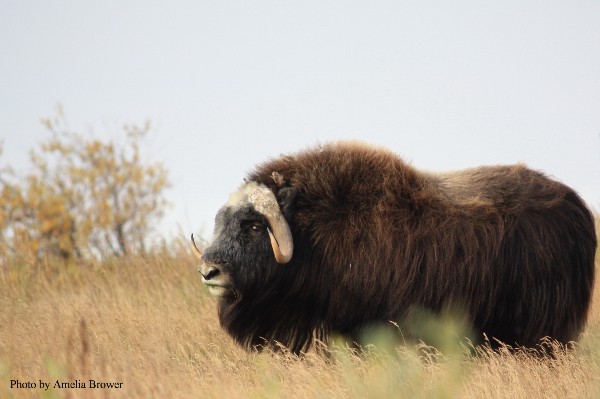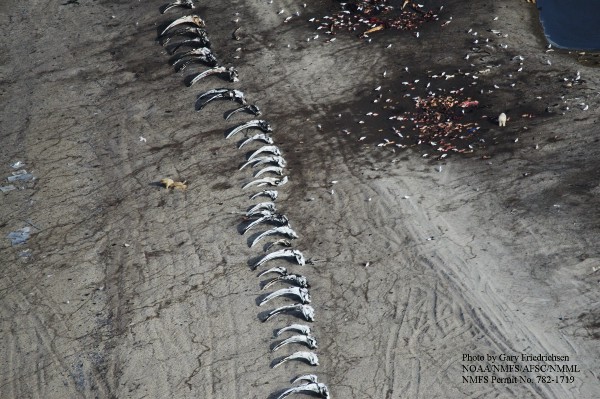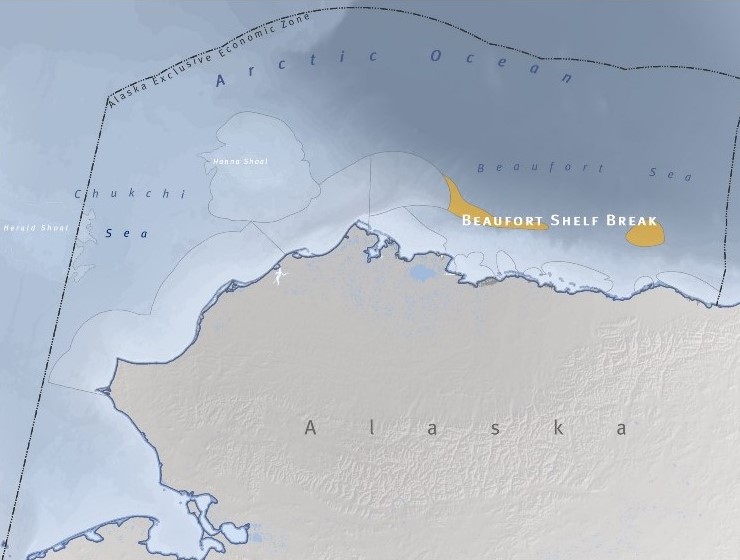Imagine standing at an airfield in the Alaska Arctic waiting for your workday to begin. Instead of a dress shirt and slacks, your business attire for the day is a bright orange suit – sealed at the wrists and neck with neoprene, designed to keep you dry if you end up immersed in water.
You look out across the expansive frozen tundra. No trees are in sight. A red fox slinks behind a building nearby and you can hear the eerie wail of a loon somewhere in the distance. A chilly breeze nips at your face and neck, and you pull your wool hat down tighter. Today, your office will be a small, fixed-wing airplane, your job will be surveying marine life and your destination will be the Beaufort Sea.
Takeoff. As the plane ascends, you have an opportunity to see this seemingly barren land from an entirely different perspective. To the south are the striking, snowcapped mountain peaks of the Brooks Range, their impressive heights magnified as they sit adjacent to the vast, flat tundra. To the east and west, endless stretches of tundra are speckled with ponds and laced with tributaries. If you’re lucky, you might see a herd of caribou as it makes its way to a river mouth, or a group of grazing musk oxen, who once nearly faced extinction. To the north is the Beaufort Sea, laden with sea ice. Few have ventured to this outlying sea of the Arctic Ocean.

Musk oxen, who once faced extinction, graze along the rivers that flow into the Beaufort Sea. (Amelia Brower)
While our airplane makes its way north at an altitude of merely 450m (1,500ft), the Beaufort Sea glistens close below. Rays of sunshine stream from the sky and you can see fully formed clouds reflected in the water. You can’t help but notice the startling contrast between strips of blackish-blue water and piercing white floes of ice. The colors and shapes of this Arctic seascape are dramatic and dynamic. Newly formed grease ice appears grayish and delicate, while the edge of the pack ice is sprinkled with bright white ice floes, creating a mosaiclike pattern. Farther out, blocks of ice are stacked high into hills where floes collide to form pressure ridges, and pools of meltwater shine a brilliant aquamarine blue.

Leads and cracks in the ice cover in the Beaufort Sea. (NASA Jet Propulsion Laboratory/Eric K)
You approach Cross Island, a small, flat, sand-covered island with a spit jutting off of its northwestern edge. Cross Island has long been used by the Iñupiat as a whale hunting encampment, and more than 40 bowhead whale skulls lined up in the sand serve as remnants and reminders of past successful hunts. Around the bones you see the cream-colored hue of polar bears. Some lounge in the sand or bask in the sun, while others swim in the surf or keep a protective eye on their cubs. The bears are drawn to this island by leftover flesh from the hunt, which offers an easy meal.

Bowhead whale skulls are lined up on Cross Island, the sign of past successful hunts. (Gary Friedrichsen)
Beyond Cross Island, the ocean stretches unbroken northward to the pole. There are no more protective barrier islands; ice floes provide the only means to dampen the Arctic winds as they whip across the Beaufort Sea. In the distance, there is a commotion of waves and whitecaps, and misty air hangs over the water. On closer inspection, you see that the turbulent water is a result of activity from bowhead whales, as they swim, dive and surface. Mud is churned up in a coffee-and-cream swirl, where these bowhead whales congregate to feed on tiny zooplankton below.
Farther offshore, you approach the shelf break where the continental shelf ends and the deep ocean basin begins. Here you find belugas, sometimes hundreds of them – bright and white, rivaling the brilliance of the ice floes around them. The young whales are still gray, having yet to change color as they mature to adulthood. As you watch the belugas swim through this ice-covered sea, their movements appear effortless and graceful.

The Beaufort Shelf Break is a major fall migratory corridor for beluga whales. (Audubon)
These moments out over the Beaufort Sea and shelf break provide just a glimpse of the natural beauty and value that the Arctic region of Alaska has to offer.
This commentary originally appeared in the Vital Arctic Ocean Areas blog, a collaboration of scientists and conservation organizations focused on important U.S. marine areas. The series highlights some of the most ecologically important marine areas in the Arctic Ocean, including the Chukchi Corridor, Barrow Canyon, Colville Delta, Herald Shoal – and more. Stay tuned.
The views expressed in this article belong to the author and may not reflect those of Arctic Deeply.
This story originally appeared on Arctic Deeply.
